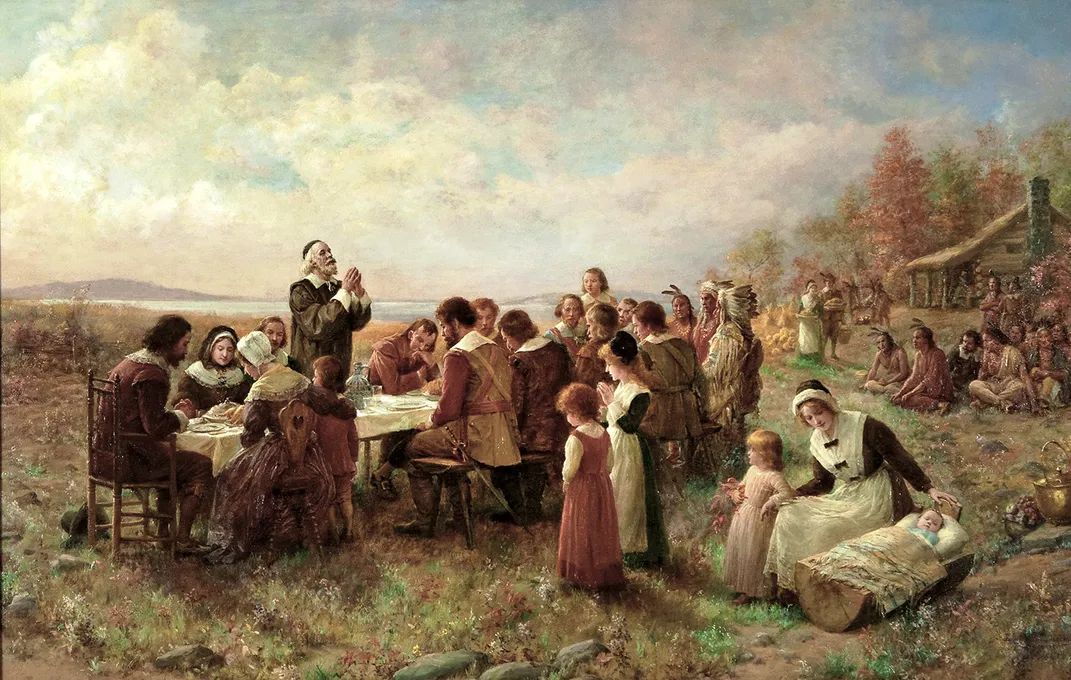NATIONAL MUSEUM OF THE AMERICAN INDIAN
Everyone’s history matters: The Wampanoag Indian Thanksgiving story deserves to be known
The Thanksgiving story deeply rooted in America’s school curriculum frames the Pilgrims as the main characters and reduces the Wampanoag Indians to supporting roles. It also erases a monumentally sad history. The true history of Thanksgiving begins with the Indians.
:focal(603x682:604x683)/https://tf-cmsv2-smithsonianmag-media.s3.amazonaws.com/blogging/featured/LandingofthePilgrims_DoS_detail.png)
“The antidote to feel-good history is not feel-bad history, but honest and inclusive history.” —James W. Loewen, Plagues & Pilgrims: The Truth about the First Thanksgiving
The Thanksgiving story you know and the one I know are most likely the same. It’s the story deeply rooted in America’s curriculum—the one that inspires arguably the most important and tradition-filled holiday in American culture. We’re taught that in 1620 the Pilgrims fled harsh religious suppression in Britain, sailed across the Atlantic, and in December stepped ashore at Plymouth Rock, in what is now Massachusetts. With little food and no shelter, the colonists struggled to survive a brutal winter until a friendly Indian, Squanto, came along and showed them how to cultivate crops. Their first harvest resulted in a feast, as the Pilgrims gave thanks to the kind Indians for helping to bring the colony back to life.
This version of Thanksgiving, while pleasant, isn’t terribly accurate. Told from a perspective that frames the Pilgrims as the main characters, the story leaves out major details, glorifying the Pilgrims’ endeavor and the holiday it birthed, forcing the Wampanoag Indians into forgotten roles. It also erases a monumentally sad history. When we pay homage to the Pilgrims and their bravery, and react to the tragic background of America's founding myth with silence, we essentially support a mindset that only some people’s history matters.

The true history of Thanksgiving begins with the Indians.
About four years before the Pilgrims anchored off Massachusetts, British fishermen had already started making their way through New England, storming through Indian towns to kidnap Native people for profit in the slavery trade. Although it’s often left out of textbooks, this series of intrusions was the catalyst to what is probably the most important event in this nation’s history, without which Europeans would not have been able to settle on top of the millions of Native people who already lived in America—at least, not as fast: epidemic illness.
Before 1492, the Western Hemisphere was largely isolated, sparing its indigenous peoples from diseases the rest of the world succumbed to time and time again. But this lack of contact prevented Natives of the Americas from developing any type of immunity to European, Asian, and African pathogens. When Europeans started trekking through Indian towns, they brought sickness with them. Indians died at an alarming rate, making it substantially easier for colonists to overpower entire villages—well, what was left of them.
The Pilgrims already believed they were part of God’s plan. Finding empty villages as 90 percent—yes, 90 percent—of America’s Indians perished in front of them only furthered Europeans’ sense of their destiny, influencing them to continue the colonization westward. As Jolene Rickard (Tuscarora) and Paul Chaat Smith (Comanche) wrote in Our Peoples: Giving Voice to Our Histories, one of the opening exhibitions at the National Museum of the American Indian in Washington, “That initial explosion of death is one of the greatest tragedies in human history because it was unintended, and unavoidable, and even inevitable. But what happened in its wake was not.”
One people who famously suffered from the onslaught of disease were the Wampanoag, a nation made up of 69 villages scattered throughout present-day Rhode Island and Massachusetts. Skilled hunters, gatherers, farmers, and fishers during spring and summer, the Wampanoag moved inland to more protected shelter during the colder months of the year. Like indigenous groups everywhere, the Wampanoag had a reciprocal relationship with nature and believed that as long as they gave thanks to the bountiful world, it would give back to them. Long before the arrival of the Pilgrims, the Wampanoag held frequent Thanksgiving-like celebrations, giving thanks in the form of feasts and ceremonial games.
Exposed to new diseases, the Wampanoag lost entire villages. Only a fraction of their nation survived. By the time the Pilgrim ships landed in 1620, the remaining Wampanoag were struggling to fend off the Narragansett, a nearby Native people who were less affected by the plague and now drastically outnumbered them.
For a moment of history, the interests of the Pilgrims and the Wampanoag aligned. When the Pilgrims landed in New England, after failing to make their way to the milder mouth of the Hudson, they had little food and no knowledge of the new land. The Wampanoag suggested a mutually beneficial relationship, in which the Pilgrims would exchange European weaponry for Wampanoag for food. With the help of an English-speaking Patuxet Indian named Tisquantum (not Squanto; he spoke English because he was kidnapped and sold in the European slave trade before making his way back to America), the Pilgrims produced a bountiful supply of food that summer. For their part, the Wampanoag were able to defend themselves against the Narragansett. The feast of indigenous foods that took place in October 1621, after the harvest, was one of thanks, but it more notably symbolized the rare, peaceful coexistence of the two groups.
The events that followed in New England also depart from the Thanksgiving ideal we celebrate. To read what happened to the New England Indians later in the 17th century, see the museum's earlier post Do Indians Celebrate Thanksgiving?
Lindsay McVay is a senior at the University of Central Florida, majoring in writing and rhetoric. Her professional experience includes writing grants for nonprofits; contributing to blogs, especially Book Baristas; and designing websites for Florida independent publishers. During the fall of 2017, Lindsay has worked as an intern in Marketing and Communications at the National Museum of the American Indian.
